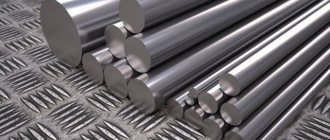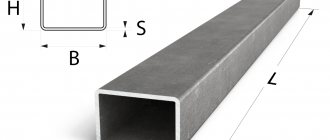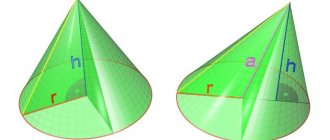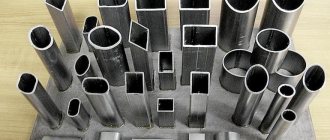If there is no possibility of direct weighing, the weight of scrap metal can be determined in other ways. The most accurate result will be given by calculation, but other possibilities should not be neglected.
So, in order not to burden readers with unnecessary formulas, which will still be there, but below, we will immediately designate the formulas for calculating the most popular products from rolled steel and pipes - rolled pipes. Here you will not find an online calculator for calculating weight, only formulas that you remember once you no longer have to use special calculators. For example, when dismantling metal structures or a chimney, you don’t always have a computer, the Internet or a reference book at hand, but the structures are all welded from rolled steel here and our formulas will help out!
Formula to calculate pipe weight
M=(Ds)*s*0.02466
, Where
- M— weight of one linear meter of pipe, kg;
- D is the outer diameter of the pipe being calculated, mm;
- s—pipe wall thickness, mm;
- 0,02466 —coefficient for steel density equal to 7.850 g/cm3.
This formula is very accurate. You can calculate the weight of the pipe and compare the calculated weight with the theoretical one in any range and the value according to the formula will be more accurate! You can also calculate
Applied examples of calculations
Specific examples will provide significant assistance in understanding the principles of calculations and the sequence of actions when performing calculations, which interested visitors should familiarize themselves with.
Task #1 - calculating the volume of coolant required
For a country house of temporary residence, you need to calculate the volume of purchased propylene glycol - a coolant that does not solidify at temperatures down to -30°C. The heating system consists of a 60 liter jacketed stove, four aluminum radiators of 8 sections each and 90 meters of PN25 pipe (20 x 3.4).
Pipes of the PN25 20 x 3.4 standard are most often used to organize a small heating circuit with radiators connected in series. Its internal diameter is 13.2 mm
The volume of liquid in the pipe must be calculated in liters. To do this, you need to take the decimeter as a unit of measurement. The formulas for converting from standard length values are as follows: 1 m = 10 dm and 1 mm = 0.01 dm.
The volume of the boiler jacket is known. V1 = 60 l.
The passport of the aluminum radiator Elegance EL 500 indicates that the volume of one section is 0.36 liters. Then V2 = 4 * 8 * 0.36 = 11.5 l.
Let's calculate the total volume of pipes. Their internal diameter d = 20 – 2 * 3.4 = 13.2 mm = 0.132 dm. Length l = 90 m = 900 dm. Hence:
V3 = π * l * d2 / 4 = 3.1415926 * 900 * 0.132 * 0.132 / 4 = 12.3 dm3 = 12.3 l.
Thus, we can now find the total volume:
V = V1 + V2 + V3 = 60 + 11.5 + 12.3 = 83.8 l.
The percentage of liquid in the pipes relative to the entire system is only 15%. But if the length of communications is large or a “water heated floor” system is used, then the contribution of pipes to the total volume increases significantly.
At industrial and agricultural facilities, homemade heating radiators are often installed, arranged like registers. Knowing the dimensions of the pipes, you can calculate their volume
Task #2 - calculating the volume of a homemade radiator
Let's look at how to calculate a classic homemade heating radiator made from four horizontal pipes 2 m long. First you need to find the cross-sectional area. You can measure the outer diameter from the end of the product.
Let it be 114 mm. Using the table of standard parameters of steel pipes, we find the wall thickness characteristic of this size - 4.5 mm.
Let's calculate the internal diameter:
d = 114 – 2 * 4.5 = 105 mm.
Let's determine the cross-sectional area:
S = π * d2 / 4 = 8659 mm2.
The total length of all fragments is 8 m (8000 mm). Let's find the volume:
V = l * S = 8000 * 8659 = 69272000 mm3.
The volume of vertical connecting tubes can be calculated in a similar way. But this value can be neglected, since it will be less than 0.1% of the total volume of the heating radiator.
The resulting value is not informative, so let’s convert it to liters. Since 1 dm = 100 mm, then 1 dm3 = 100 * 100 * 100 = 1000000 = 106 mm3.
Therefore V = 69272000 / 106 = 69.3 dm3 = 69.3 l.
Large radiators or heating systems (which are installed, for example, on farms) require significant volumes of coolant.
Therefore, since it will be necessary to calculate the volume of pipes in m3, then all dimensions will need to be immediately converted into meters before substituting them into the formula.
Task #3 - calculation of the required length of PP pipes
You can get the fragment length using an ordinary ruler or tape measure. Minor bends and sagging of polymer pipes can be neglected, since they will not lead to a serious final error.
With such curvature of polymer pipes, their length will be significantly greater (10-15%) than the length of the section along which they are laid
To maintain accuracy, it is much more important to correctly determine the beginning and end of the fragment:
- When connecting a pipe to a riser, the length must be measured from the beginning of the horizontal fragment. There is no need to grab the adjacent part of the riser, as this will lead to double counting of the same volume.
- At the entrance to the battery, you need to measure the length up to its tubes by grabbing the taps. They are not taken into account when determining the volume of the radiator according to its passport data.
- At the entrance to the boiler, you need to measure from the jacket, taking into account the length of the exiting pipes.
Curves can be measured in a simplified way - consider that they run at right angles. This method is acceptable, since their total contribution to the length of the pipes is insignificant.
If you have a layout diagram of the heated floor, you can calculate the length of the coolant pipes according to the plan with a scale grid applied to it
The volume of a warm floor is calculated by the footage of installed pipes.
If there is no length data or diagram, but the pitch between the tubes is known, then the calculation can be carried out using the following approximate formula (regardless of the installation method):
l = (n – k) * (m – k)/k
Here:
- n – length of the heated floor section;
- m – width of the heated floor section;
- k – pitch between tubes;
- l is the final length of the tubes.
Despite the small cross-section of the pipes that are used for water heated floors, their total length leads to a significant volume of coolant contained.
So, to provide a system similar to the figure above (length - 160 m, outer diameter - 20 mm), 26 liters of liquid will be needed.
Calculating the weight of a sheet of metal
M=S*7.85
, Where
- M—mass of steel sheet, kg;
- S is the area of the calculated sheet, in square meters;
- 7.85 - weight of a sheet 1 mm thick and 1 square meter in area, in kilograms
This way you can calculate the weight of a sheet of metal of any size, for which you can calculate the area. The accuracy of calculations using this formula is higher than the theoretical mass in reference books, because in the assortment, when calculating the mass of metal, the program rounds the values. Well, how to find out the area of a sheet (of any shape - square, rectangle, parallelepiped, trapezoid, rhombus, etc.) - every person who has graduated from high school should know.
How to calculate the weight of reinforcement and rod
For a circle, rod, smooth reinforcement, the formula for calculating the mass will be as follows:
M=(0.02466*D2)/4
, Where
- M—weight of 1 linear meter of circle/reinforcement/rod, kg;
- D—circle diameter;
- 0,02466 —coefficient for steel density equal to 7.850 g/cm3
To calculate the weight of corrugated reinforcement (A2, A3), you can and should use the same formula! There will be no discrepancies with the theoretical mass, despite the different cross-sectional designs.
It is, of course, impossible to calculate such a pile of scrap metal using formulas without weighing
Online metal calculator
Rolled metal includes all products that have been hot or cold rolled on special machines. Today there are many species with different characteristics. It is impossible to remember the density of each metal and alloy. Therefore, it is extremely difficult to calculate tonnage. To do this, use the metal calculator on our website. He will quickly make calculations based on the characteristics of the product.
General approaches or a little boring theory
To determine the weight of any object, simply multiply its volume by its specific gravity. If everything is more or less clear with specific gravity, then volume is more difficult to determine (if you do not consider such simple shapes as a cube). The most general principle for calculating volume is Gulden's principle, when the cross-sectional area of an object is multiplied by its height. There are also usually no problems with the height of the metal structure; it is easy (or almost easy) to measure directly, especially if the height section is constant. This can be done for steel pipes of any section and profile, I-beams, channels, angles, etc. We will consider the method for determining the mass of metal objects of complex and variable shapes later.
Gravity in calculations
The weight of a body is proportional to its mass and depends on the acceleration of gravity. It is found by the formula: P=mg (g - gravity). The unit of force is the SI Newton (N). This quantity, unlike mass, is not a constant inherent to the body. It depends on the location of the body relative to the surface of the Earth. And it will also change when an object moves with acceleration (w) according to the formula P=m (gw). In addition, force always has a direction (vector quantity).
Accordingly, specific gravity (γ—gamma) is the ratio of weight to volume: γ = P/V. Its value is also not constant, but the unit of measurement is N/m³ (in SI). Continuing the transformations, we get the following: γ=mg/V=ρg. This means that in order to put the specific gravity of metals into a table, you need to multiply the corresponding density by gravity. And with accelerated movement the values will be different.
For scientific work, such tables are necessary . In ordinary life they are used extremely rarely. The substitution of concepts: mass - weight, density - specific gravity occurred during the transition to a unified system of measures and weights. Decades have passed since then, but the use of incorrect expressions has persisted.
Volume of a truncated pyramid
The enclosing caps, protective latches and doors have the shape of a truncated pyramid. In such situations, a dependency is used:
, Where:
- h – height of the truncated pyramid;
- F is the area of its larger base;
- f is the area of the smaller base.
If the pyramidal part of the structure sold for scrap is somewhat deformed, then the missing volume is added or removed from each side.
conclusions
Despite the fact that the network offers us a huge selection of software products for calculating the coolant volume, there are GOST tables for determining the internal volume of pipes, you need to know the principles of “manual” calculations.
They are necessary for those who independently construct and repair communications, and for those who use the services of design and construction organizations. Useful information will help you determine the material consumption before installing the system, accurately calculate the estimate and get an idea of upcoming operating payments.
Would you like to talk about how you calculated the volume of coolant for an autonomous heating system in a country house or country house? Do you have information that might be useful to site visitors? Please write comments, post photos related to the topic of the article, and ask questions in the block below.
Volume of wedge and obelisk
The wedge in the technique is often a pentahedron, the base of which is a rectangle, and the side faces are isosceles triangles or trapezoids. The formula for calculating the volume of a wedge is:
, Where:
- a – side of the base of the wedge foot;
- а1 – width of the wedge top;
- b – wedge thickness;
- h is the height of the wedge.
An obelisk is a hexagon, the base of which is rectangles located in parallel planes. The opposite faces are symmetrically inclined to the base of the obelisk. Volume of this geometric body:
, Where:
- a and b – dimensions of the length and width of the larger base of the obelisk;
- and a1 and b1 – the smaller base of the obelisk;
- h – height of the obelisk.
Volumes of rolled profiles
Most often it is necessary to determine the weight of tees, I-beams, channels, and angles. The following dependencies are used for this:
For the brand
,where b and b1 are the width of the shelf and wall of the tee, respectively; h and h1 – thickness of the base and flange of the tee; H – height of the T-bar fragment;
For I-beam
,where H is the height/length of the I-beam; a – I-beam wall thickness; с and с1 – thickness of the I-beam flange at the base and at the end, respectively;
For the corner
,where H is the length of the corner; l1 – angle thickness; h1 and h2, respectively, are the width of each shelf.











